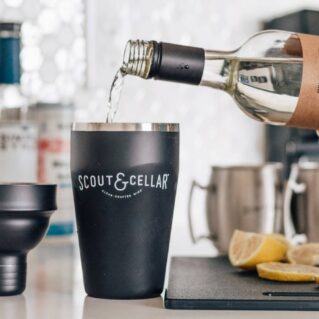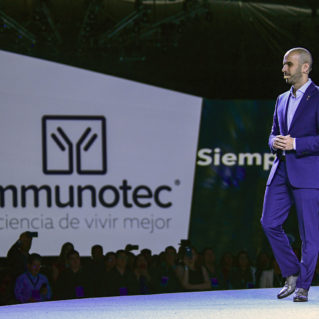Founded: 2007
Headquarters: Dallas, Texas
Executives: Veeral Rathod, CEO and Co-Founder
Products: Custom clothing and accessories
J.Hilburn set out to build a better menswear brand and modernize made-to-measure men’s clothing a decade ago. The company and its founding team were powered by possibility and unhindered by the constraints of what they believed to be an antiquated apparel industry.

Veeral Rathod
Executives balked at apparel traditions like simple sizing and bulk production—processes that cause long planning and production timelines, drive high product markups and kill innovation. Instead, they prioritized “fit” and high-touch personalized service, and then set about pioneering a scalable supply chain that made good on a brand promise to bring personal style, character and class back to men—one shirt, one suit, one man and one measure at a time.
“Our goal is to preserve the core elements of custom clothing, such as unique sizing patterns for each client, a wide array of personalization options and high-quality construction, while delivering industry-leading production times, quality and consistency,” says Veeral Rathod, CEO and Co-Founder.
“We do not fit the traditional mold for an apparel brand, a retailer or a direct selling company. We value innovative thinking above all else,” he says.
One Shirt, One Suit, One Man, One Measure at a Time
At launch, J.Hilburn offered a solitary clothing staple for men: the custom dress shirt. Soon its product line expanded to include suits, sport coats, trousers, outerwear, neckwear and belts. All the while, the company beat back such typical apparel roadblocks as compressed margins, heavy inventory and even heavier working capital needs with its commitment to made-to-measure products. But it also faced and conquered production obstacles, including product inconsistency, long delivery times and high prices by tapping an unlikely source—the automotive industry.
|
The team’s lack of experience in the apparel industry drove them to think differently about problem solving. They adopted a “single-piece flow” philosophy, borrowed from car manufacturers, which reimagined material planning, production and shipping processes. In doing so, J.Hilburn benefited from the efficiencies of traditional batch or bulk garment production, while manufacturing custom units. Some 10 years later, intent focus on planning and daily execution is still key to making it work.
Larry Hagenbuch, COO/CFO, says each and every product requirement—each fabric, each option, each measurement—is mapped from J.Hilburn’s ordering platform to the factory’s production system, material handling system and various automated pattern makers and fabric cutters.
J.Hilburn employs weavers, designers, leathersmiths and tailors from Portugal, Malaysia, Vietnam, Thailand and the U.S. The company sources raw wool fiber from New Zealand and Australia and raw cotton from the U.S and Egypt’s Nile River basin, and 96 percent of all of J.Hilburn’s fabrics are made in Italy. Every one of these manufacturing partners is part of the overall mapping system that allows a J.Hilburn Personal Stylist to enter an order that will be cut by an automated, pattern-matching, numerically controlled cutter within 24 hours.
By embracing the essential elements of single-piece flow, J.Hilburn also drives employee accountability and quality control. Employee training is extensive, and throughout production, scanners and RFID (radio-frequency identification) technology provide individual work instructions and garment inspection records. Hourly internal quality audits and a robust corrective action process reduce defects and improve existing processes. Good wages, respectful and dignified work environments, employee promotions and some subsidized housing programs contribute to employee satisfaction and high-quality products.
All orders and forecasts arrive electronically each day at J.Hilburn’s manufacturing partner factories and fabric mills. Real-time sales information and monthly, 12-month forecasts allow the weekly flow of necessary fabrics from mill to factory and provide time for production to plan capacity and labor needs months in advance. Automatic links between inbound logistics suppliers, UPS and U.S. customs systems further streamline product delivery.
“The result is custom shirts delivered anywhere in the U.S. in less than two weeks—usually one week—while the industry average is four to six weeks; suits are delivered in the U.S. in three to four weeks, while the industry average is six to eight weeks,” Hagenbuch says.

J.Hilburn’s Personal Stylists—70 percent of whom are female—bring their own personal style, work with passion every day and build essential, long-term client relationships.
Personal Stylists: The Power of the Brand
J.Hilburn’s continued growth is powered by technology innovations, including those that empower its salesforce of Personal Stylists to better serve clients.
“Our first priority is to earn your trust by delivering the best-fitting clothing in your closet in a highly efficient way—an accomplishment built upon a personal relationship,” Rathod says.
Personal Stylists—70 percent of whom are female—are the face of J.Hilburn and an asset that cannot be centralized or automated. They come from all backgrounds, bring their own personal style, work with passion every day and build essential, long-term client relationships. While a great deal is required of them—expertise in measuring, fit and styling, client acquisition and retention, as well as business operations—their businesses engage creativity and offer flexibility, professional development, and best-in-class compensation.

There can, however, be a steep learning curve, so it’s imperative J.Hilburn continues to strengthen and advance training programs and “fit” innovations. In 2017, the company launched T.A.P.E., a proprietary digital fit tool that uses an ever-learning algorithm to help Stylists define a client’s fit preference, which is often a daunting task.
Now Stylists have a simple technology to assist them at the point of sale to ensure they capture measurements and fit preferences correctly.
“T.A.P.E. has quickly become a Stylist favorite recruiting tool too, as it showcases our company’s stand on technology and our vision of making fit personal and easy,” says Eric Frank, Vice President, Product Design and Merchandising.
In the coming year, J.Hilburn will turn its attention to Stylist training. The executive team is studying strong consumer companies such as Starbucks and Disney, to better understand how to train and onboard, in order to deliver memorable experiences. They will also train on all things fashion—fit, styling, menswear trends and wardrobe building.
A team of top J.Hilburn Stylists will guide all new training initiatives and content going forward. They expect to use more online/web-based technology to create training and user-friendly modules focused on content-driven material made ready, as Stylists need it. This should ease new Stylists into J.Hilburn’s complicated made-to-measure product offering, while simultaneously building their teams.
“This will be the evolution of our School of Style program that is focused on continued education, cultural immersion and community building—led and owned by Stylist Ambassadors and Stylist Mentors,” Frank says.
|
Tending to the Stylist/client relationship is already a highly digital experience and will continue in 2018. J.Hilburn’s corporate team creates easy, digital client encounters with new products and promotions. A few times each month, established clients receive email featuring a wardrobe staple, such as “The Perfect White Shirt.” With a simple click, they can connect to their Personal Stylist, who has stored their measurements, and place an order. Seasonal “Look Books” are also offered digitally. Corporate-driven communications let Stylists follow up with clients and deliver highly personalized shopping experiences through a combination of technology and face-to-face encounters.
“Our Stylist productivity has grown nearly 50 percent over the past two years, and our average Stylist productivity is more than $50,000 per year,” Rathod says.
The Evolving Business of Dressing Well
“J.Hilburn benefits from a healthy financial strength through virtually zero inventory and neutral working capital. We’ve solved the biggest financial constraints that apparel companies face,” Rathod says.
Ultimately, this translates to high value to clients, who are accustomed to J.Hilburn’s modern menswear point-of-view, its curated seasonal fashion collections, and service of Stylists, all of which help them navigate an ever-evolving men’s dress code.
As men travel more and lines between professional occasions, social events and family time blur, they want well-crafted, well-fitting clothes that are comfortable and versatile—no matter how formal or informal the dress code. This fall, J.Hilburn launches its first made-to-measure sportswear collection.
|
This new tailored-in-between sportswear intersects luxury and leisure and provides a slightly dressed-down version of highly tailored suiting merged with a less athletically inspired, dressed-up, easygoing sportswear. Polos, chinos, five-pockets and outerwear, in a variety of curated fabrics and a wide range of styling options to satisfy both traditional and modern tastes, will be available.
Performance tailoring—specifically engineered to withstand the impact that extensive travel has on clothing—is a new option, but the real story could be in the fabrics. Traditional sportswear and technical clothing required synthetic fabrics—think Spandex—for stretch and chemicals for performance. But no more. J.Hilburn’s new made-to-measure sportswear collection offers 100 percent Italian wool fabric that delivers stretch without synthetics and is specially finished to be waterproof using a 100 percent organic treatment.
“This means you can put the suit on in the morning, get on a plane, get rained on, run all over town, and still show up looking sharp,” Rathod says.
Rathod says made-to-measure sportswear is a game changer. It has strong appeal for men working in tech and marketing and helps J.Hilburn transition clients from suits to a new dress code.

J.Hilburn CEO and Co-Founder Veeral Rathod (left) walks the mill floor with Alessandro Barberis, CEO of Vitalie Barberis Canonico.
Innovation Above All Else
“Our business is very unique in that our Stylists are not consumers of the product and our consumers are rarely potential Stylists. We need to develop strong capabilities in new customer acquisition, retention and lifetime value,” Frank says.
Brand awareness and brand presence drive new customers to the brand, so J.Hilburn is combining direct selling with storefront retail to accomplish their goals. J.Hilburn Studio opened in Dallas in 2014, but was reimagined last fall as a brand studio, client destination and Stylist training site.
|
New clients can walk into J.Hilburn Studio anytime during retail hours, see the brand, feel the fabrics, try on fit samples, work with the full-time corporate team to complete first fittings and get paired with local Stylists. Then they can begin to shop however they would like—in-store, online, or in their own offices.
“We are seeing higher order sizes and customer frequency,” Frank says.
Additionally, J.Hilburn is piloting Stylist Showrooms, a multiuse space in local markets for training, recruiting and sales. A partnership with co-working space company WeWork gives J.Hilburn access to excellent urban commercial buildings, like WeWork’s Tower 49 in midtown Manhattan where a Stylist Showroom opens in October.
New York City is a vibrant market for J.Hilburn. In fact, it is the company’s fastest-growing city marketplace. Stylists from Long Island, New Jersey and Connecticut meet clients there, and the WeWork space provides retail brand awareness in a most competitive fashion market.
The company is beginning to host trainings and trunk shows at other WeWork spaces around the country, and Frank expects to set up permanent showrooms in these spaces over the next two years.
“Our vision is to build the most personal brand, and these retail locations give us a presence to further connect with our Stylists and clients,” Frank says. Thus far, performance of both strategies is positive. The Dallas Studio will generate $1,000 sales per foot within the first 12 months and New York is trending to double that.
Rathod sums up J.Hilburn’s ultimate goal: “Get the fit right, tell the client what to wear and offer him interaction through multiple channels—in person, digital and retail. When he looks good, he is more confident. When that confidence comes because his Personal Stylist makes it easy, he is a loyal client for life.”
Click here to order the October 2017 issue in which this article appeared.


